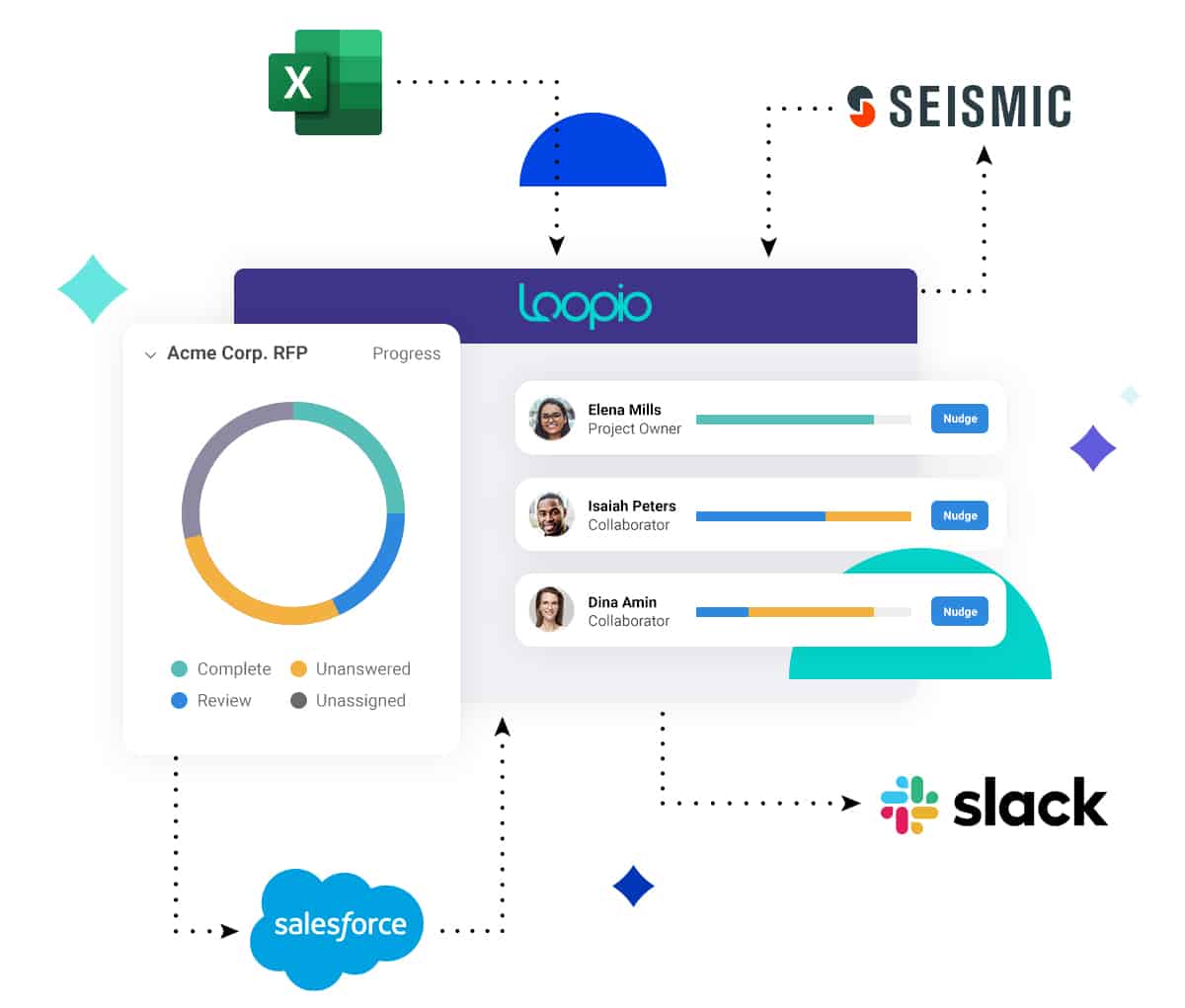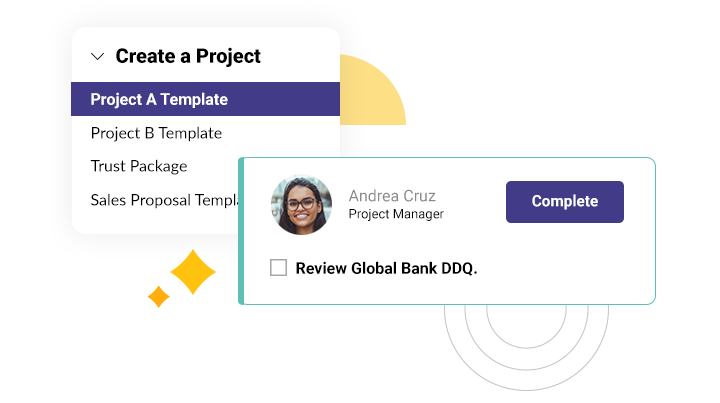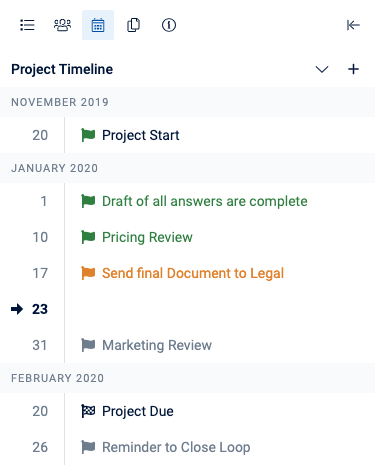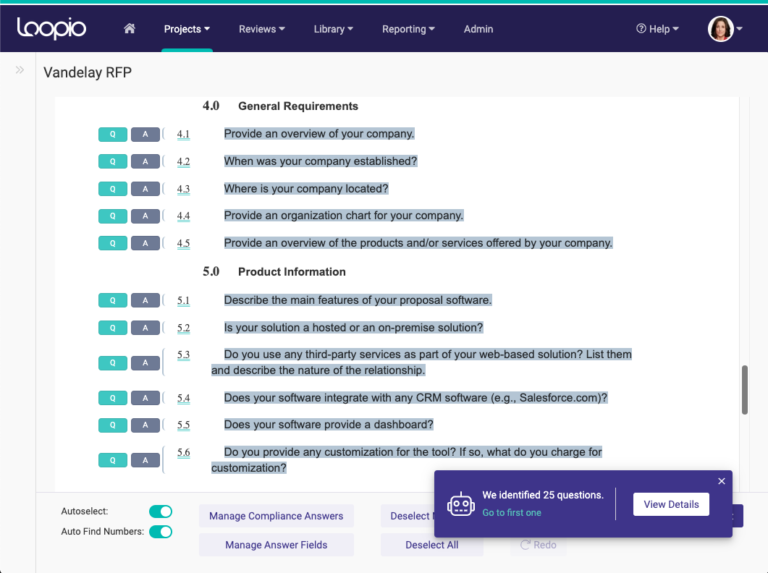RFI Software
Complete Your RFI Process
in Record Time
Want to see more? Complete the form to see a 4-minute product walkthrough.
Trusted by 1,500+ Leading Brands








Harness Simple, Yet Powerful Integrations
Never choose between quality and speed again. You can connect your tools—from Loopio to Salesforce—to submit bids on time, every time.

What is RFI Software?
A request for information—also known as an RFI—is a document that companies send to vendors as part of the procurement process to understand more about their business.
RFI software helps sales and proposal teams through the process of responding to these detailed business documents. But how exactly? Keep reading and find out.
The reality is that filling out responses requires a lot of back-and-forth communication with colleagues over email, which is tedious and time-consuming. But with RFI software, you can assign specific sections to your teammates in the software directly and monitor your team’s progress.
The RFI meaning in business is to request information. It gives a chance for the buyer to get to know the market better and potentially revise the project guidelines before they get to the RFP phase, where they’ll request a proposal. It also helps the buyer whittle down the list of suppliers to their top choices. As a vendor, you’ll need to respond to these RFI questions to be considered for this opportunity.
With RFI management software, you can respond to all types of requests quickly and easily. For example, when receiving a request, you’ll be able to import all the questions directly into your RFI software. Once imported, the software should help you identify questions that need answers within the document.
Tools like Loopio help streamline the RFI process by centralizing your best content, then using automation to auto-fill the first pass of answers. The platform simply pulls past RFI answers from your content library for each request, so you don’t have to start from scratch for every new submission.
RFI vs. RFP: What's the Difference?
An RFI and RFP are two of the most common “request” documents in the procurement process. Let’s compare and learn about the differences between these two important documents: RFI vs. RFP.
The procurement process typically starts with an RFI, then comes the RFP. Basically, a buyer uses the RFI to learn about the market. Then, after narrowing down to their preferred vendors, the buyer prepares a document that describes the project in detail and asks for vendors to answer questions, explaining how they’d get the job done. (This is the RFP process in a nutshell.)
-
What is an RFP?
RFP stands for ‘request for proposal.’ It is a document that asks vendors to submit proposals, in order to win business for a particular contract.
-
What is an RFI?
RFI stands for ‘request for information.’ It is a document which asks vendors to submit information about their business—typically a precursor to asking for a full proposal.
Stylistically, RFP responses are usually allowed a few more liberties regarding the format of your response. In contrast, an RFI response tends to be more strict and standardized in a specific form.
Plus, depending on the size, structure, and industry of the companies involved, answers may be more formal or casual. For example, healthcare organizations are typically publicly funded—which means that compliance and vendor regulations are strict and must follow a specific stand. That’s why it’s incredibly common to see RFI and RFP in healthcare.
It may sound simple, but these documents can be hundreds of questions long. This means you need solid RFI and RFP project management skills to complete these documents—especially when you’re juggling several in a condensed time period.
For example, a construction RFI may be used to shortlist vendors for construction projects. Construction RFPs are often used to rule out (or in) competitors, and this is commonly used in construction management, especially those funded by public money where a fair buying process (and impartiality) is key.
RFP project management becomes easier when using software, because these tools offer a way to assign and keep track of individual tasks of this project.
Want to learn about automation for RFIs and RFPs? Read about RFP automation software.
Create RFI Software Templates Faster
You can make the process faster by creating branded RFI templates. (Templates are a great way to get something done quickly). Create reusable templates for proposals, SOWs, and other documents that match your brand’s visual style.
RFI Template Example:

The key benefits to using an RFI software template are:
- Saving time on manual data entry and design
- Helping the sales team move faster
- Ensuring your document is on-brand every time
- Create consistent responses that pull from the same data, no matter who is replying
How to Use RFP Tracking Software to Manage RFIs
RFI management can be a difficult task for any growing business. RFI documents are typically stored in specific folders, limiting visibility and access. (Or even worse—stored through email chains or Slack messages.)
So, how do you track RFIs? To work efficiently and ensure valuable information is automatically stored in a central location, many professionals use RFI tracking software (a.k.a RFI management software).
One central platform allows users to monitor the progress of these documents and stay on top of RFIs automatically. This software is a central platform that provides a shared location for storing and accessing all RFIs in the organization while simultaneously providing project management capabilities.
For example, you can set clear deadlines for each project and tag other team members as needed (example below) to keep projects moving forward.
This is much better than relying on an RFI tracker Excel spreadsheet because the status of each project is changed automatically as team members check off tasks, ensuring that things not only get done in a timely manner but that everybody stays on the same page, ultimately increasing your chances of project success.
However, it’s important to note that even with an RFI tracker template in your software, you should still kick off the project by meeting with relevant subject matter experts (SMEs). Whether you meet in real life or through a video call, it’s important to gather everyone to determine requirements, assign responsibilities, and set expectations. Clear communication is essential to making the entire process go smoothly.

This is much better than relying on an RFI tracker Excel spreadsheet because the status of each project is changed automatically as team members check off tasks.
However, it’s important to note that even with an RFI tracker template in your software, you should still kick off the project by meeting with relevant subject matter experts (SMEs). Whether you meet in real life or through a video call, it’s important to gather everyone to determine requirements, assign responsibilities, and set expectations. Clear communication is essential to making the entire process go smoothly.
Take a Peek: RFI Response Examples
The core purpose of any response document (RFP RFI, RFQ RFX) is to see if a company is a good fit for a particular project. On the receiving end, you must read each document carefully to determine if you really are a good fit before filling out responses.
If you are a good fit, look at other RFI response examples to get a sense of how you should structure your response before replying.
Example Response (RFI Template for Software)

Sample RFI Questions:
- What is the size of your company?
- When was your company founded?
- Tell us about your organizational structure.
- What are your company's short-term goals?
- What is the long-term vision for the company?
- What services and products do you offer?
- What makes you different from your competition?
It’s important to remember that templates will change drastically depending on industry requirements. For example, private buyers in a fast-growing software industry may move much faster through the RFI process than a government contractor, which is likely under a greater amount of scrutiny as a public-buyer.
So, how do you write a software RFI?
There are the top considerations to prepare for when answering a software request for information
✓ Provide a concise description of how your solution solves the buyer’s problem
✓ Key differentiators that explain how you’re different than competitors in the G2 grid
✓ Evidence that you can solve the problem through your solution and your team (customer testimonials are important)
✓ Customized answers to questions that specifically speak to this buyer’s needs
✓ A complete response that addresses all points within each question
As you can see from the example above, RFI questions and requirements are fairly straightforward. The trick is providing quality answers on a short timeline. That’s where Loopio’s content library becomes helpful. You can store previous RFI answers in a centralized location to easily apply to each new request. This way, you’ll be able to spend less time searching for answers and more time customizing to appeal to that specific buyer.

